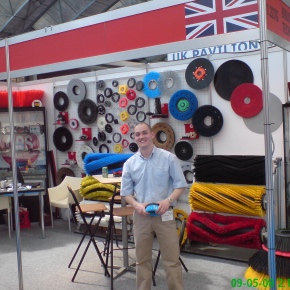
How to lower overheads by going eco-friendly
Barry Cracket is a product designer at Brushtec, an industrial brush manufacturer that has significantly lowered its overheads and increased profit margins by adopting eco-friendly practices throughout the company. In this article, he takes a closer look at what Brushtec did to achieve this and how you could too.
Over the past decade, the worldwide financial crisis has put a wide variety of industries under pressure, forcing many businesses to look for ways to cut costs or face going under. Here at Brushtec, we work with a number of clients who are spread across many sectors, so this affected our sales as a consequence.
In response, we decided that we would have to analyse our expenses and adjust them accordingly. As a manufacturing firm, one of our biggest overheads has always been the amount of energy we consume, so this was the first area that we looked at. We conducted an in-depth review of our energy use, where it became clear that we could make significant savings by embracing greener, power-saving technology.
Taking the time to audit your own energy consumption is always a worthwhile task. It enables you to see where you’re using the most power and where you could make improvements. Using the data from this audit, you can make informed decisions at the boardroom level, before putting a plan into place that could serve as the turning point for your business’s fortunes.
We had been looking to move our operation to a new factory for a while, so we decided to combine our ambitions to cut our energy overheads with our need to relocate. The result was a plan for a new facility that made use of the latest energy-saving tech to cut costs and increase profits, all while making us a much more sustainable business on the whole.
The first improvement we decided to make was to switch our factory lighting from outdated incandescent bulbs to energy-efficient LED models. Though the initial investment was costly — coming in at around £100 per bulb — after only one year the bulbs paid for themselves and now offer nothing but savings when compared to the lighting we’d used previously. In addition, these bulbs have allowed us to take a significant step toward our goal of running a more eco-friendly operation while cutting costs.
Another area we identified for potential savings was in how we heated our factory, so we looked to improve its insulation, while investing in more eco-friendly heating options. We had thermal-efficient cladding installed, as well as an insulated automatic high-speed shutter door that can open and close in three seconds. We also switched to 93% efficient gas-fired heaters and a ground source heat pump, providing us with greener sources of warmth that also help to keep energy costs lower.
The last major enhancement we made to our facility was to add a solar photovoltaic system to provide a reliable source of sustainable electricity. With energy prices set to rise over the coming years, being able to generate our own supply will help to insulate us from these costs by reducing our reliance on the national grid. By replacing a sizeable slice of our total consumption with free electricity, we’ve been able to lower our overheads even further.
While you can make many of the major changes to your premises that we have at Brushtec, it’s also important that you don’t forget to look at the small gains too. For example, we installed hand dryers in our toilets that generate 70% less carbon emissions than a combination of paper towels and warm air dryers. Though they might seem rather underwhelming on their own, when you look at the bigger picture, these small enhancements really count too.
The difference that embracing sustainable technology in our factory has made to our energy overhead spending can be measured in numbers. We’ve reduced our monthly power bills from £5,000 to just £3,000, representing a huge saving. Couple that with the reduction of CO2 emissions by 9,000kg a month, and you can see that the changes we’ve made have been hugely positive for both our operating costs and the environment around us.
Latest news

22nd November 2024
Insight Data: Using Marketing Data to Build a Successful Business in 2025
Alex Tremlett, Insight Data’s Commercial Director, discusses the challenges for construction firms in 2025 and shares six strategies for success…
Posted in Articles, Building Industry News, Building Services, Information Technology, news, Research & Materials Testing
22nd November 2024
Purplex: A tough Budget, but opportunity still knocks
Incoming governments, especially those with significant mandates, inevitably come into power on a tidal wave of optimism coupled with hope that ‘Things can only get better’. Andrew Scott, MD of construction-focused, full-service agency Purplex, talks…
Posted in Articles, Building Industry News, Building Services, Information Technology, news, Posts, Research & Materials Testing
22nd November 2024
Pop Up Power Supplies Gets Arty in Yorkshire
Pop Up Power Supplies has installed 13 new electricity units at The Hepworth Wakefield – read more in this article…
Posted in Articles, Building Industry News, Building Products & Structures, Building Services, Case Studies, Civil Engineering, Facility Management & Building Services, Garden, Hard Landscaping & Walkways, Landscaping, Posts, Restoration & Refurbishment, Retrofit & Renovation
22nd November 2024
OPT Services Revolutionises Fibre Cable Capping with Eco-Friendly Innovation
UK-based OPT Services has unveiled SlimLine™ Capping, a groundbreaking fibre cable protection solution that promises to deliver significant environmental and installation advantages to the fibre optic industry.
Posted in Articles, Building Industry News, Building Products & Structures, Building Services, Facility Management & Building Services, Information Technology, Innovations & New Products, Sustainability & Energy Efficiency
 Sign up:
Sign up: